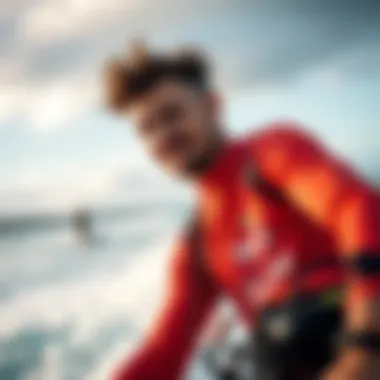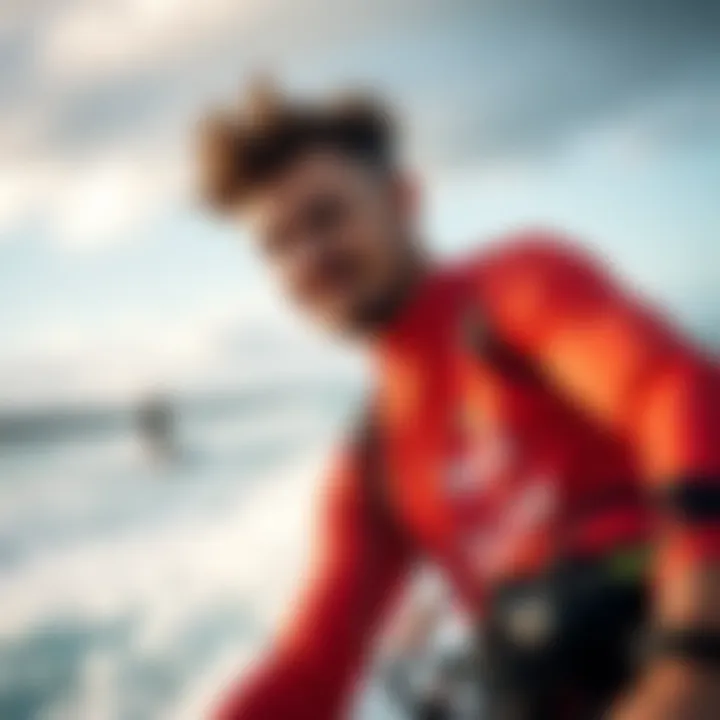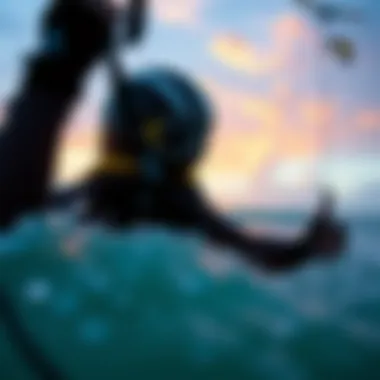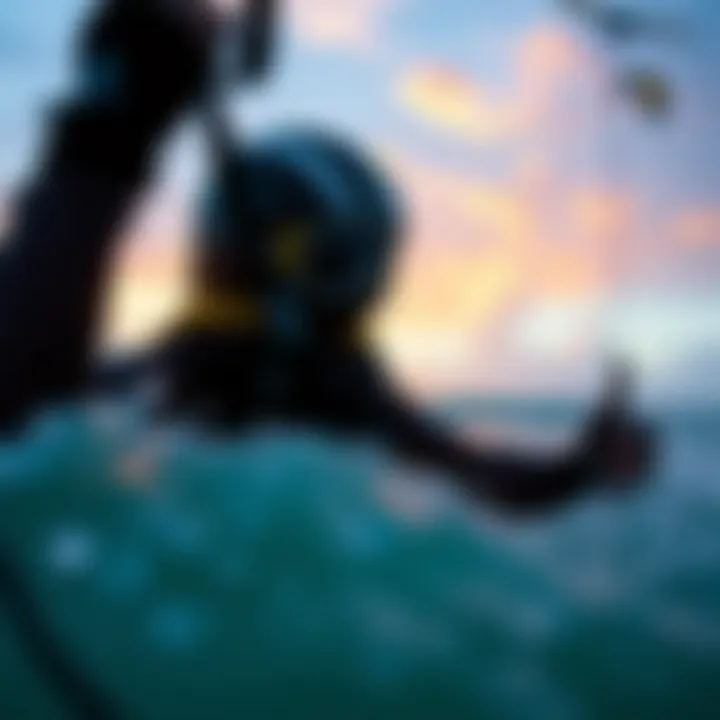IKO Community Management in Kiteboarding: A Deep Dive


Intro
The kiteboarding community has evolved into a vibrant ecosystem, fueled by passions, experiences, and shared growth. At the heart of this thriving culture lies the International Kiteboarding Organization (IKO), a body dedicated to nurturing the sport and its enthusiasts. As kiteboarding gains momentum across the globe, understanding how community management works within this sphere is indispensable.
The IKO's approach is a tapestry woven with threads of inclusivity, education, and safety—elements that not only define best practices but also enhance the kiteboarding experience for everyone. Whether you're a seasoned rider or a beginner just learning the ropes, being part of this community can make all the difference.
Now, as we embark on this journey, we will unpack various aspects of IKO's community management strategies. From gear selection that suits different styles to techniques that shape riders' skills, this article serves as a comprehensive guide that aims to inform and inspire.
Let’s delve into the first component of this exploration: gear selection.
Gear Selection
When it comes to kiteboarding, having the right gear is a crucial step that lays a solid foundation for the sport. The choices one makes can determine not just performance but also enjoyment. The IKO recognizes this, providing a framework for selecting equipment that fits each rider's style and needs.
Types of Kites
Understanding the different types of kites is key to making an informed choice. Kites vary in shape, size, and construction, and each design caters to specific conditions and riding styles. Common types include:
- C Kites: Known for their powerful lift and responsiveness, these kites are popular among freestyle and competition riders.
- Bow Kites: Offering a larger wind range, these kites are designed for ease of use, appealing to both beginners and those looking to cruise.
- Delta Kites: With their unique shape, delta kites provide excellent stability and power, ideal for wave riding.
- SLE Kites: These provide a mix of power, ease of use, and hang-time, suitable for a wide range of conditions.
Choosing the right kite largely depends on the rider's skill level and the conditions in which they'll be flying. Factors like wind strength, rider weight, and personal preference should influence this crucial decision.
Choosing the Right Board
Board selection is equally important, as it can significantly affect performance. Just like kites, boards come in various shapes and sizes to suit different riders and conditions.
- Directional Boards: Ideal for wave riding, these boards are designed to move with the waves and are best for more experienced riders.
- Twin Tip Boards: Very popular among freestyle and freeride enthusiasts, these boards are versatile and allow riders to ride in both directions.
- Foil Boards: Rising in popularity, foil boards offer a unique riding experience that involves gliding above the water’s surface, creating less drag and providing a different sensation altogether.
Selecting a board can depend on aspects such as the type of riding you wish to pursue and environmental conditions. The melding of kite and board should be well thought out to create a harmonious balance, resulting in a more enjoyable experience.
"Choosing the right gear can sometimes feel like finding a needle in a haystack. However, the IKO emphasizes that the perfect match is out there, waiting for each individual rider."
As kiteboarding evolves, the gear choices continue to expand, making it essential for riders to stay informed about the latest advancements.
Next, we will transition our focus toward Skill Development, as mastering techniques remains the backbone of any kiteboarding journey.
Understanding IKO Community Management
In the rapidly evolving landscape of kiteboarding, understanding the framework established by the International Kiteboarding Organization (IKO) is akin to having a map in unfamiliar terrain. The IKO not only serves as a regulatory body but also plays a critical role in shaping the kiteboarding community, steeped in principles that foster inclusivity, education, and safety. Grasping the nuances of IKO Community Management is essential for riders of all levels, instructors, and event organizers alike. It harmonizes the diverse threads of human experience on the water, aiming to cultivate a vibrant, welcoming environment.
The significance of comprehending IKO’s approach lies in its multifaceted benefits. Firstly, it encourages a cohesive community where every kiteboarder, whether a novice or a seasoned professional, feels they have a place. The community thrives on shared knowledge and experiences; thus, understanding IKO's principles invites more meaningful connections. When everyone is on the same page, the safety concerns that often plague extreme sports can fall to the wayside, allowing for more enjoyable experiences.
Additionally, as kiteboarding grows in popularity, the needs and expectations of both individuals and organizations are constantly shifting. By exploring the competencies and responsibilities that IKO outlines, participants in the sport can better adapt to changes, learn from one another, and support new entrants without the confusion that often accompanies a hobby with such complex dynamics.
"Community management in kiteboarding isn't just about membership; it's about building bridges and ensuring that everyone can ride the wind safely together."
This exploration into IKO community management also sets the foundation for discussing the core guiding principles that have been established, which serve not only as guidelines but are also the backbone of the kiteboarding culture. These principles will lead us to a clearer understanding of how the IKO fulfills its mission and the long-lasting implications it has for practitioners around the world.
Definition and Purpose of IKO
The International Kiteboarding Organization (IKO) is a pivotal entity in the kiteboarding world. Founded to establish standards and promote the sport, the IKO acts as a central hub where enthusiasts can come together, share experiences, and learn from one another. The core purpose of IKO lies in creating a safer, more inclusive environment for kiteboarding enthusiasts.
Much of what IKO achieves is rooted in its comprehensive support structure, including educational resources, instructor certifications, and safety protocols. These elements combine not just to enhance individual skills but create a functional and sustainable community that nurtures new talents while honoring those who have dedicated years to mastering the craft.
The Evolution of IKO's Role
As kiteboarding gained momentum, so too did the need for organization and structure. Initially, the support available was sporadic and informal, leaving many riders to fend for themselves, which often led to misunderstandings and safety risks. Recognizing these challenges, the formation of the IKO marked a transformative period. Today, it stands as a beacon, guiding both seasoned riders and newcomers alike.
Over the years, IKO has continually adapted its focus to meet the evolving landscape of kiteboarding. From establishing rigorous safety standards to creating a network of instructors worldwide, each step taken has been towards solidifying a global community. The role of IKO has shifted from merely overseeing regulations to actively cultivating connections among riders, schools, and organizations, thereby enriching the kiteboarding culture on a global scale.
Understanding these elements is imperative in appreciating the depth of the IKO's impact on the community. It’s this evolution that encapsulates the essence of learning, growth, and community spirit, ensuring that kiteboarding remains accessible and safe for everyone.
Core Principles of IKO Community Management


In the landscape of kiteboarding, the International Kiteboarding Organization (IKO) serves as a lighthouse guiding not just enthusiasts, but the entire community toward common principles that define safe and enjoyable kiteboarding experiences. These core principles form the backbone of how IKO operates and aims to enhance community engagement.
Inclusivity and Accessibility
Inclusivity and accessibility are foundational to IKO's mission. Kiteboarding should not be an exclusive club; it’s a world open to everyone, irrespective of age, gender, or skill level. IKO works to ensure that all kiteboarders, from those just starting to seasoned pros, feel welcomed.
- Initiatives: Programs like 'Kite for All' aim to provide resources and training for individuals with disabilities. This approach breaks barriers, allowing a wider range of individuals to engage in the sport.
- Local Schools and Communities: Partnerships with local schools engage youth through beginners’ clinics. Inclusive practices allow newcomers to learn in a supportive environment, fostering friendships and shared experiences.
- Global Reach: Using an online platform, IKO connects riders around the globe. It encourages shared learning and friendship through diverse cultural exchanges, making kiteboarding a truly international endeavor.
Respect for the Environment
Environmental respect is not just a trendy term for IKO; it’s embedded in their ethos. As kiteboarders, being stewards of our natural playground matters. The waves, wind, and beaches we cherish are also ecosystems that deserve protection. Here’s how IKO contributes:
- Sustainable Practices: IKO runs educational workshops on sustainable kiteboarding, helping the community understand how to minimize their impact. From waste management to using eco-friendly materials, the guiding principle is to enjoy the sport without adverse effects on nature.
- Advocacy for Conservation: Collaborating with coastal authorities and conservation groups, IKO actively participates in beach clean-ups and wildlife protection efforts. By highlighting the importance of clean coastlines, they emphasize that a healthy environment sustains the activities we love.
- Awareness Campaigns: Through social media and partnerships, IKO raises awareness of environmental issues affecting kiteboarding. As a result, riders learn to advocate for policies supporting sustainable practices.
Skill Development and Safety
Safety is a non-negotiable aspect of kiteboarding, and IKO recognizes that skill development is critical to ensuring that riders can enjoy the sport safely. The focus on ongoing training extends beyond basics:
- Structured Training Programs: IKO certification programs for instructors ensure that they are up to date with safety protocols and best practices. Not only do they teach riders the technical aspects, but they also instill safety consciousness from the start.
- Regular Safety Workshops: IKO organizes workshops focused on emergency procedures and risk assessment. Attendees learn how to anticipate dangers, manage equipment failures, and respond to unforeseen circumstances. This pragmatic approach operationalizes safety through education.
- Community Feedback: Riding safely means adapting to constantly changing conditions. IKO encourages community feedback to refine safety guidelines and protocols. As conditions evolve in different locales, the input from local riders is invaluable to enhance collective safety.
"A community deeply engaged in its safety practices is one that inspires confidence and fosters a lasting enthusiasm for the sport."
Through these core principles—Inclusivity, Respect for the Environment, and Skill Development and Safety— members of the IKO community can build not just their individual capabilities but also a robust culture surrounding kiteboarding. The aim is to create an environment where everyone feels empowered to thrive.
Relevant Resources
Building Connections in the Kiteboarding Community
Building connections within the kiteboarding community is more than just sharing the love for the sport; it’s about cultivating a network that fosters growth, support, and shared knowledge among enthusiasts. This interconnectedness can lead to a richer experience for riders, regardless of their skill level. Establishing strong bonds within this community emphasizes teamwork, collaboration, and a sense of belonging while allowing participants to share resources and best practices. The connections made through IKO not only enhance personal experiences but also drive the community forward as a whole, making kiteboarding more accessible and enjoyable for everyone.
Networking Strategies for Riders
Networking in the kiteboarding community is crucial for both budding riders and seasoned pros. Here are a few strategies that riders can adopt to effectively build their network:
- Join Local Clubs: Becoming part of local kiteboarding clubs is a great way to meet like-minded individuals. These clubs often organize events, clinics, and meet-ups where one can learn and share experiences.
- Utilize Social Media: Platforms such as Facebook and Instagram can be leveraged to connect with others in the kiteboarding scene. Joining groups, sharing your kiteboarding journeys, or engaging in discussions can open doors for collaborations and friendships.
- Attend Events and Competitions: Participating in local, national, or even international kiteboarding events is an excellent way to broaden your horizons. These gatherings provide opportunities to connect with riders, instructors, and enthusiasts from various backgrounds.
- Mentorship Programs: Seeking or offering mentorship can create bonding experiences within the community. Experienced riders can guide newcomers, sharing valuable tips while forming lasting relationships.
By implementing these strategies, riders can cultivate a network that supports skill development and safety awareness, essential for thriving in the kiteboarding realm.
Collaborative Efforts with Local Schools
Another significant aspect of building connections in the kiteboarding community is collaborating with local schools. This cooperation can take various forms:
- Kiteboarding Programs: Schools can establish kiteboarding programs that introduce students to the sport. Instructors can volunteer to teach basic skills and safety protocols, providing a solid foundation for new riders.
- Educational Workshops: Organizing workshops where local instructors share knowledge about the equipment, techniques, and safety can create an informed generation of kiteboarders.
- Community Events: Schools can host kiteboarding festivals that invite families and local residents to engage in the sport. This expands the reach of kiteboarding and increases community awareness, focusing on inclusiveness and participation.
- Inter-school Competitions: By facilitating friendly competitions among schools, communities can foster a spirit of camaraderie while also engaging students physically and mentally.
Through these collaborative efforts, kiteboarding can transform into a community activity that promotes teamwork, healthy engagement, and shared experiences, paving the way for a new generation of enthusiasts.
Communication in the IKO Framework
Effective communication stands at the core of the International Kiteboarding Organization's (IKO) community management. It's a nuanced landscape where every voice, every idea, and every piece of feedback is indispensable in shaping the kiteboarding experience. Here, engaging with community members, instructors, and stakeholders is not just a formality; it's a lifeblood that fuels growth, safety, and connection among kiteboarders.
The importance of communication transcends mere information sharing. It builds trust and collaboration between members of the kiteboarding community. Through various channels, IKO encourages open dialogues that help to understand the diverse perspectives and needs of kiteboarders worldwide. As the saying goes, "Good fences make good neighbors," but in this case, good communication builds a community. It fosters a family atmosphere where both novice and seasoned riders can thrive.
Online Platforms for Interaction
The digital age has brought unprecedented opportunities for connectivity, and IKO has fully embraced this. From social media platforms like Facebook (https://www.facebook.com) to dedicated forums such as Reddit (https://www.reddit.com/r/kiteboarding), these online spaces offer kiteboarders an ever-present network for support, inspiration, and collaboration.
- Information Sharing: Community members can post questions about gear specifics, weather updates, or local wind conditions, ensuring that everyone is on the same page regarding safety and enjoyable experiences.
- Inspirational Content: Many riders frequently share videos of their tricks and experiences, encouraging others to push their limits and celebrate the sport's lifestyle.
- Skill Development: Online tutorials and webinars become a resource for aspiring kiteboarders. They often adopt a peer-to-peer teaching approach, facilitating growth and more profound understanding.
Harnessing the power of these platforms, IKO not only gathers feedback but also encourages discussions about best practices, fostering continuous growth and an innovative spirit among its members.
Event Coordination and Feedback


Events are where the real magic happens. They provide kiteboarders a chance to meet face to face, learn from one another, and build lasting relationships. Organizing these events efficiently requires a solid communication framework to ensure that everything runs smoothly.
- Pre-Event Communication: Clear communication before events is essential. Information such as dates, locations, schedules, and safety guidelines need to be disseminated widely. A well-informed crowd is a happy crowd, after all.
- During Events: Real-time updates through messaging platforms can help keep participants informed about changes or important announcements.
- Post-Event Feedback: After the festivities, gathering feedback from participants—be it via surveys or informal chats—allows the community to assess the event's success and pinpoint areas for improvement. IKO uses this feedback to enhance the experiences for future events, aligning with its commitment to fostering growth and encouraging engagement.
In summary, the IKO’s communication strategies are crucial for steering the kiteboarding community toward a harmonious and progressive future. By leveraging both digital platforms and event interactions, IKO not only strengthens the bonds among its members but also nurtures a thriving culture centered on safety, education, and shared enjoyment.
"Communication is the key to understanding and collaboration in any thriving community."
More resources on kiteboarding community management can be found at Wikipedia or Britannica.
Safety Protocols Established by IKO
In the dynamic and exhilarating world of kiteboarding, where the exhilaration of soaring over water meets the powerful gusts of wind, safety stands out as a non-negotiable element. The International Kiteboarding Organization (IKO) has put in place comprehensive safety protocols that not only guard against risks but also enhance the overall kiteboarding experience for riders of all skill levels. The importance of these protocols cannot be overstated. They serve as a backbone, ensuring that enthusiasts can enjoy their passion without unnecessary worry. This section dives into the significance of safety in kiteboarding, the vital role of instructors, and the standards for training and certification that keep practitioners safe.
Importance of Safety in Kiteboarding
Safety in kiteboarding is crucial because it directly impacts the well-being of each participant. A lack of safety measures could lead to accidents and injuries that tarnish the sport’s reputation. It is not merely about avoiding mishaps; it’s about fostering a culture of vigilance and care within the kiteboarding community. Here are several key reasons why safety is paramount:
- Accident Prevention: Effective safety protocols minimize the risk of accidents, allowing riders to focus on their skills and enjoyment.
- Confidence Boosting: Knowing that safety measures are in place helps in boosting the confidence of beginners and experienced kiteboarders alike. They can fully immerse themselves in the experience without fear of what might go wrong.
- Community Trust: Establishing robust safety standards helps build trust among community members. When safety is prioritized, riders feel more secure and supported, creating a thriving kiteboarding environment.
Role of Instructors in Promoting Safety
Instructors are the touchstone of safety protocols within the IKO framework. They are not just teachers; they are safety ambassadors. Their responsibility goes beyond imparting technical skills. They play a fundamental role in shaping a safety-oriented mindset among their students. Some of the critical functions of instructors in promoting kiteboarding safety include:
- Demonstration: Instructors illustrate best practices through demonstrations, allowing students to understand the importance of each safety measure.
- Risk Assessment: They assess conditions and inform riders of the risks specific to each location and weather scenario, guiding them in making informed choices.
- Emergency Preparedness: They train students on how to handle emergencies, instilling confidence in their ability to react swiftly and appropriately.
Training and Certification Standards
The IKO’s comprehensive training and certification standards lay the foundation for effective community safety. These protocols ensure that every rider, from novice to expert, adheres to a consistent level of safety awareness. IKOs training framework includes several essential elements:
- Practical Training: Practical experiences make safety knowledge applicable. Participants engage in real scenarios that hone their skills while reinforcing safety principles.
- Theoretical Knowledge: Alongside practical skills, understanding the theory of kite dynamics, weather patterns, and risk assessments is crucial. Comprehensive training addresses these aspects, ensuring riders are well-rounded in safety knowledge.
- Certification Levels: The IKO offers multiple certification levels designed to cater to different skill sets. Each level builds on safety principles, ensuring advancing riders remain equipped to handle more complex situations.
"Safety is not a gadget but a state of mind." - Eleanor Everet
The safety protocols established by IKO are not merely administrative formalities; they are vital to the continued enjoyment and sustainability of kiteboarding as a sport. By prioritizing safety, embracing instructor responsibility, and adhering to rigorous training standards, the kiteboarding community can ensure a safer and more enriching experience for every individual involved.
The Benefits of Joining the IKO Community
Joining the International Kiteboarding Organization (IKO) community brings a variety of benefits that cater to everyone from novice riders to seasoned professionals. Embracing this community means more than just improving your skills on the water; it's about becoming part of a larger family that values safety, learning, and growth. In this segment, we will dive into specific elements that underline the significant advantages of membership.
Access to Professional Networks
Being part of the IKO community opens the gates to a plethora of professional networks. Kiteboarding can be a competitive arena, but IKO works diligently to create connections that extend beyond the sport.
- Industry Expertise: Members can tap into a rich pool of knowledge shared by instructors, seasoned riders, and industry professionals. This helps in learning the ropes of not just kiteboarding, but also the business side of things.
- Mentorship Opportunities: Newer riders can find mentors who can guide them in their progress, not just in tricks but in navigating the kiteboarding culture. Having someone in your corner can make all the difference as you strive to improve.
- Networking Events: IKO organizes various events and meetups that bring people together. These events are more than just social gatherings; they provide opportunities for collaboration, skill exchange, and even partnerships for local schools and businesses.
Educational Resources for Continuous Learning
The kiteboarding world is always evolving, and so is the need for up-to-date information and skills. IKO provides a treasure trove of educational resources aimed at fostering a culture of continuous learning.
- Workshops and Training: Regular workshops are a staple of the IKO community. These sessions focus on skill development, safety protocols, and progressive techniques. Whether you want to master a new trick or understand proper gear maintenance, there’s always something to learn.
- Online Learning Modules: IKO offers digital resources that are available at your convenience. This flexibility allows you to learn at your own pace, whether it’s about safety regulations or teaching methods for aspiring instructors.
- Latest Trends and Techniques: As kiteboarding advances, new styles and techniques emerge. Members gain access to articles and tutorials that keep them informed on what’s new in the sport.
Participation in Global Events
Being part of the IKO community means being in the loop for a variety of global events. These gatherings enhance camaraderie and serve as an excellent platform for riders to showcase their talent.
- Competitions: Members are encouraged to participate in competitions that are held around the globe. These competitions allow riders to test their skills under pressure and gain exposure to international kiteboarding scenes.
- Festivals and Gatherings: Events like kiteboarding festivals create a vibrant atmosphere for riders and enthusiasts alike. They celebrate the sport and provide a perfect setting for networking with like-minded individuals.
- Travel Opportunities: Being part of IKO can also open doors to traveling opportunities to different kiteboarding hotspots around the world. Imagine the thrill of riding in exotic locations, meeting new riders, and sharing experiences!
Challenges in Community Management
Community management in kiteboarding is akin to steering a ship through unpredictable waters. The importance of understanding the challenges in this area cannot be overstated, as they directly affect the overall health of the kiteboarding community and the experiences of its members. By navigating these obstacles thoughtfully, the International Kiteboarding Organization (IKO) can enhance engagement, ensure safety, and promote enjoyment for everyone involved.
One of the key elements in community management is addressing the varied skill levels of riders. There are seasoned pros who can execute complex tricks, and then there are beginners who are just beginning to find their feet. The disparity in skill can create tension if not handled properly. Engaging both groups requires an understanding approach, one that respects the expertise of veterans while encouraging newcomers. Workshops, mentorship programs, and skill-sharing events can help bridge these gaps, turning potential conflicts into opportunities for shared growth and learning.


Engagement with Diverse Skill Levels
When it comes to engagement with diverse skill levels, the challenge lies in creating an inclusive environment where every rider feels valued and has access to the resources they need. A common pitfall is the tendency to cater mainly to the advanced kiteboarders, inadvertently sidelining novices. This not only dampens the enthusiasm of newcomers but also risks losing potential future enthusiasts.
To combat this, IKO could implement varied programs that focus on different aspects of kiteboarding:
- Beginner Workshops: These sessions can be tailored to address essential skills, safety protocols, and techniques to build confidence on the water.
- Intermediate Clinics: For those who are ready to take the leap, intermediate events can help bridge the gap to advanced riding, facilitating partnerships among riders of different skill levels.
- Advanced Training: This program can feature experienced instructors who provide specific insights into performance tweaks, advanced safety measures, and competition preparation.
Encouraging interactions between different skill levels is vital. One way to foster this is through buddy systems, pairing experienced kiteboarders with newbies. This mentorship not only reinforces skill development but also cultivates friendships that enhance the overall community spirit.
Maintaining Safety and Enjoyment
Safety is the bedrock of any sport, and kiteboarding is no exception. The challenge, however, lies in balancing rigorous safety protocols while ensuring that riders enjoy themselves. Often, discussions surrounding safety can create anxiety, especially among beginners.
To tackle this, IKO must communicate safety measures in a manner that is both clear and approachable. Employing engaging visuals in safety briefings, using clear language during orientations, and incorporating gamified aspects into learning can demystify safety protocols and add a fun element to the mix.
Additionally, frequent safety drills and interactions between instructors and attendees can reinforce the importance of being knowledgeable about safety.
"Safety is not just a guideline; it's an attitude that every kiteboarder needs to adopt. Everyone must feel responsible and empowered to look out for themselves and each other."
It’s equally critical to consider the enjoyment factor. Riders should never feel as though they are tip-toeing through a minefield when they’re hitting the waves. One effective strategy can be to create a culture that celebrates not only skill but also the spirit of kiteboarding itself – the sheer joy of gliding on water, the thrill of wind in the sails, and the camaraderie of shared experiences. Events that focus on fun, like kiteboarding exhibitions or informal meet-ups, can weave safety and enjoyment together, showing that they are not mutually exclusive.
Through attentive community management that prioritizes diverse skill engagement and balances safety with enjoyment, IKO can pave the way for a more vibrant and connected kiteboarding community, ensuring riders of all levels feel welcomed and empowered.
The Future of IKO Community Management
The landscape of community management within the kiteboarding realm is ever-evolving. As we delve into the future of the International Kiteboarding Organization (IKO) community management, it’s crucial to grasp not just its current state, but where it's headed in the coming years. The future holds immense potential for enhancing the kiteboarding experience through innovative approaches that foster inclusivity, educational opportunities, and safety practices. We are in a time where technology and community can blend seamlessly, providing a solid foundation for kiteboarding enthusiasts to thrive.
Given the increasing number of participants and the growing presence of the sport globally, understanding IKO's forward-looking strategies is key. This relates to developing robust engagement platforms and establishing programs that address the diverse needs of riders worldwide. The subsequent sections will explore how embracing technology and expanding programs are pivotal components of this evolution.
Embracing Technology in Community Interaction
We're living in a digital age where technology shapes every aspect of our lives, including sports and leisure activities like kiteboarding. The integration of technology into community management presents numerous opportunities for IKO. Whether it’s through the use of app-based communication platforms, online learning modules, or virtual events, technology can significantly enhance interaction and engagement within the community.
- Mobile Applications: Imagine a kiteboarding app that connects riders for local meet-ups, skill-sharing sessions, or competition notifications. Such an app could streamline communication, making it easier for riders to engage with each other and with local instructors.
- Virtual Learning: Online platforms can host webinars or tutorials from seasoned kiteboarders, allowing enthusiasts to learn new techniques from the comfort of their own homes. This is beneficial especially for novices looking to gain skills without the pressure of in-person classes.
- Social Media Integration: Utilizing platforms such as Facebook and Reddit can provide spaces for discussions, sharing experiences, and gathering feedback on events or safety practices. This connectivity not only strengthens community bonds but also creates a sense of belonging for members.
“The best connections happen online before we even hit the water.”
Embracing these technological advancements can allow IKO to enhance its community outreach and provide a more engaging experience for all members, keeping pace with the trends that today’s kiteboarding community expects.
Potential Growth and Expansion of Programs
Looking into the future, the IKO community management landscape will likely expand its program offerings significantly. The need for varied programs that cater to different geographical locations and skill levels is paramount.
- Localized Training Programs: Developing programs centered around specific regions can address unique environmental conditions and cultural aspects of kiteboarding. For instance, coastal communities in diverse climates may need specialized training that considers local wind patterns and safety regulations.
- Youth and Inclusivity Initiatives: Future programs could focus on youth engagement and promoting participation among underrepresented groups in the sport. Initiatives designed to introduce kiteboarding to schools or community centers can not only increase participation but also foster a new generation of environmentally-conscious and safety-aware kiteboarders.
- Collaborative Events: By encouraging collaboration with other organizations or communities, IKO can assist in organizing more events that not only promote competition but also the fun and camaraderie that kiteboarding promises. This can provide riders at all levels opportunities to connect, learn, and grow together.
The IKO community has an exciting pathway ahead. By focusing on technology integration and expanding its program offerings, the organization can continue to champion kiteboarding as an inclusive, accessible, and fundamentally enriching sport for everyone.
Final Thoughts on IKO’s Community Impact
The influence of the International Kiteboarding Organization on kiteboarding communities around the globe is far-reaching. This section aims to reflect on the profound effects of IKO's community management strategies, emphasizing how they nurture growth, foster connections, and enhance safety in the sport. Notably, it’s essential not just to talk about the structures in place but also to explore how these systems translate into real-world benefits for kiteboarders, instructors, and enthusiasts alike.
Fostering a Global Mindset
One of the remarkable contributions IKO brings to the table is its commitment to developing a global mindset within the kiteboarding community. This isn’t merely a matter of connecting different riders across geographical boundaries; it’s about cultivating a culture where experiences and learnings can circulate freely.
By hosting global events and providing forums for discussion, IKO encourages individuals from diverse backgrounds and skill levels to engage with one another. The emphasis on sharing knowledge—a kiteboarding tip learned in Australia can cross-ocean to inform a novice in Brazil—creates an enriching tapestry of shared experience. Everyone comes together under the same passion, which promotes solidarity and unity.
Furthermore, the educational initiatives that IKO implements, including training programs and workshops, teach kiteboarders to appreciate and respect multiple perspectives. The more riders understand their counterparts' stories, struggles, and unique conditions, the better they can adapt. In our own way, kiteboarding turns into a canvas painted with many colors, resonating beyond its physical borders.
Encouraging Sustainable Kiteboarding Practices
Sustainability in kiteboarding should be seen as more than just a trend; it’s an urgent necessity that IKO is helping to champion. Sustainable practices aren’t just about minimizing environmental impact; they involve the entire ecosystem surrounding kiteboarding. From the materials used in equipment to the conservation of natural sites for kiting—it impacts both the sport and the environment.
IKO actively engages with local communities to promote environmental stewardship. This includes clean-up sessions on beaches, awareness campaigns about fragile ecosystems, and developing partnerships with environmental organizations. The result is twofold: it helps protect the beautiful spots where we kite and teaches riders how to coexist with nature.
Moreover, encouraging sustainable practices enhances the overall kiteboarding experience. Riders increasingly seek locations that prioritize conservation efforts, understanding that ecosystems must remain balanced for future generations of kiteboarders. Through its influence, IKO cultivates responsible kiteboarding culture, creating a legacy that riders can be proud of.
"The future of our sport relies not only on the thrill we seek but also on how we preserve the playgrounds we love."
Overall, IKO has a significant role in molding a kiteboarding community that values connection and responsibility. Its initiatives promote personal growth, mutual respect, and conscientious practices—all vital for the flourishing of the sport. By embracing these elements, IKO doesn’t merely impact current generations of kiteboarders; they pave the way for a sustainable future in kiteboarding.















